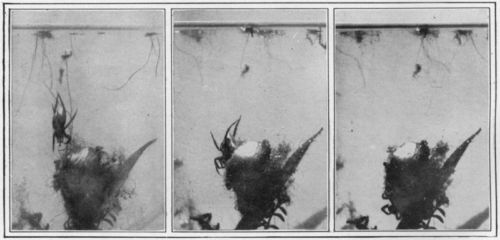May 30

Diving Bell Spider, from The Outline of Science, 1922
- 1793: May 30, 1793 – Fyfield sprung a brace of pheasants in Sparrow’s hanger. Hail-like clouds about.
- 1792: May 30, 1792 – My table abounds with lettuces, that have stood the winter; radishes; spinage; cucumbers; with a moderate crop of asparagus.
- 1791: May 30 1791 – Cinamon-roses blow.
- 1790: May 30, 1790 – John Carpenter brings home from the Plashet at Rotherfield some old chest-nut trees which are very long. In several places the wood-peckers had begun to bore them. The timber & bark of these trees are so very like oak, as might easily deceive an indifferent observer, but the wood is very shakey, & towards the heart cup-shakey, so that the inward parts are of no use. They were bought for the purpose of cooperage, but must make but ordinary barrels, buckets, &c. Chestnut sells for half the price of oak; but has some times been sent into the King’s docks, & passed off instead of oak.
- 1787: May 30, 1787 – Lactuca virosa spindles for bloom: the milky juice of this plant is very bitter, & acrid.
- 1786: May 30, 1786 – Honey-suckles begin to blow. Columbines very fine. Mr. Richardson has left us.
- 1780: May 30, 1780 – Columbines, a fine variegated sort, blow.
- 1778: May 30, 1778 – Barn-owls are out in the day, taking their prey in the sunshine about noon.
- 1776: May 30, 1776 – Strawberries blow well. The first effectual rain after a long dry season.
- 1774: May 30, 1774 – The shell of the martin’s nest begun May 16 is finished.
- 1772: May 30, 1772 – Tortoise eats all day. In Mrs. Snooke’s ponds are vast spiders, which dive and conceal themselves on the undersides of plants, lying on the water: perhaps aranea aquatica Linn: urinatoria. The swallow seems to be the only bird that washes itself as it flies, by dropping into the water.
Notes
Fyfield was Gilbert White’s spaniel, replacing Rover who died in 1789.
Cup-shakey– meaning the rings of the wood come apart like the layers of an onion.
Lactuca virosa, wild lettuce– the juice is well-known to herbalists as a mild narcotic and ointment.
The diving bell spider, whose astounding life-style, or oeconomy, is fairly well described in this 1795 article from The General Genteel Preceptor. Diving bell spider fact: When the oxygen in the air in the bell has been consumed, the spider tears the balloon. The air goes to the surface and patiently, the spider darns the bell and again fills it with fresh air. “Here are some beautiful pictures of their underwater nests (warning: pictures of large spiders).
Additional note: in trying to find early references to the diving bell spider, stumbled across this absorbing read: Harmonies of Nature from 1815, which amongst other things approaches a theory of the global plankton cycle, and speculates about crowds of animals rushing seasonally to the poles of Mars to avail themselves of the ice.
 Theme Ported to
Theme Ported to